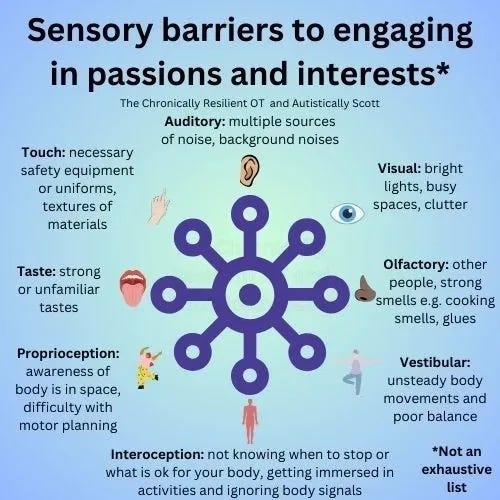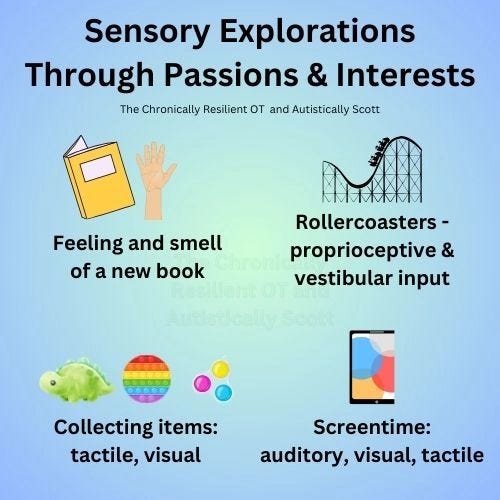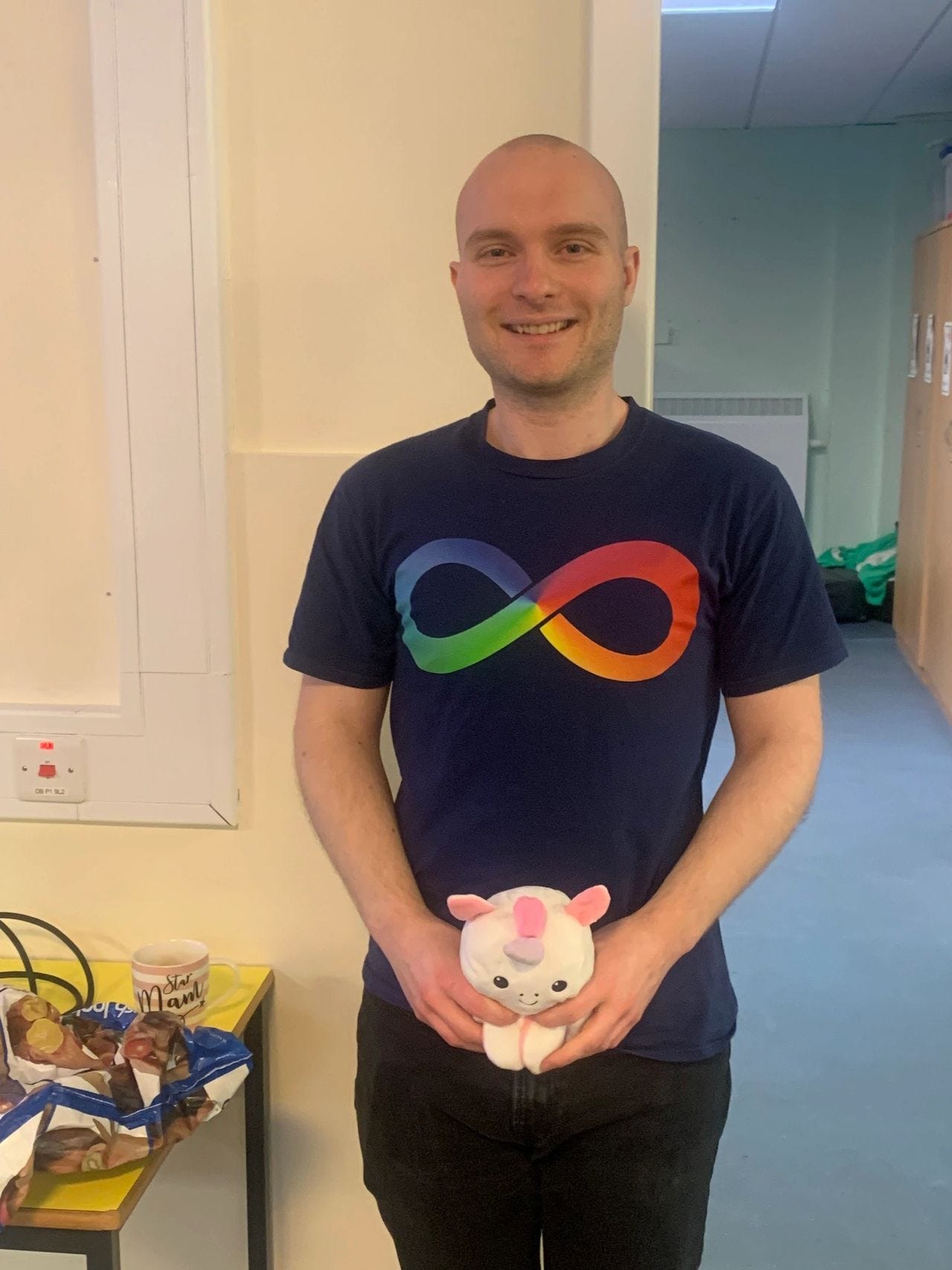How our Sensory Experiences Impact our Passions and Interests
Written by Page Guides Scott Neilson & Rebecca Rae Hodgson
This is a department introduction, created to share the aims of the department and give an overview of the kind of creative work, themes, and articles you can expect to find featured here.
Everything we do and experience has a sensory component so of course our sensory processing can impact how we participate in our passions and interests. We might have chosen specific interests because they bring us sensory joy or we might avoid some things because they would be too overwhelming for our senses.
The senses were described in the launch issue and more information can be found here (https://www.chronicresilienceot.com/blog/sensory-processing-systems-and-patterns). The eight senses are sight, sound, touch, taste, smell, vestibular (balance), proprioception (sense of body in space) and interoception (internal body senses).
Sensory supports might help us to engage in our interests and passions e.g. fidget toys, background music, weighted items. Utilising our fidget and stim tools to engage with our interests can enhance our connection to our passions and allow us to feel joy through them. Without using my (Scott) fidget tools when watching a screen or listening to music, it can be hard to engage as much with that passion. Reading physical books engages our proprioceptive and touch senses and this increase in sensory input might support engagement for some people. Personally I (Rebecca) love the smell of books as well. Note: reading in other formats is also completely valid and in no way inferior to physical books, maybe you love comics, graphic novels, audiobooks, whatever the format, it is still reading.
There might also be some sensory barriers to accessing our interests (e.g. certain textures, sounds, large groups of people) and we might need to do other things to accommodate ourselves if we still want to engage in that thing, such as wearing gloves, using noise cancelling headphones or scheduling time for interests with small groups of people.
Choice of environment can also impact our participation and we might be able to tolerate certain sensory inputs in some settings e.g. attending a loud concert of your favourite band that you’ve chosen to attend might be possible and enjoyable, but a forced family dinner in a busy restaurant is a very different sensory experience with lots of barriers. Also just because you’ve enjoyed something it doesn’t mean you don’t still need recharge time. Things fluctuate and there are many reasons that just because you can tolerate a sensory experience in one setting, that doesn’t mean you are able to tolerate a similar sensory experience in another setting. Many vulnerability factors come into play too, like overwhelm, tiredness, stress, hunger etc. This can be tricky for others to understand. For me meaning, interest and choice play a big part. Also remember Autism + environment = outcome, context matters.
For many Autistic people, interoceptive cues like hunger or thirst can easily get missed and when focused on an interest or passion these cues can be ignored for hours and you might suddenly come out of a flow state and be starving and really busting for the toilet! If you know you have a tendency to do this you might have water and snacks handy or set a timer for a bathroom break.
Another tricky aspect of engaging in passions and interests is having conflicting sensory needs with others around you and figuring out how to balance these. This could be when engaging in an interest solo and the impact this has on other people around you (e.g. listening to loud music) or when engaging in an interest with a group (e.g. playing board games and some people needing background music while others need quiet). This then becomes a balancing act for managing different sensory needs and is likely to require some negotiation, along with good communication and understanding of needs, self-advocacy, planning and potentially compromise and accommodations. For the examples above this could look like:
Listening to loud music - planning set times for playing music or using headphones
Group board games - negotiating type and volume of background music, wearing headphones or earplugs
Interoception and emotions - anxiety and excitement can feel very similar in the body, so someone might think they are anxious but actually they are excited and anticipating their interests and passions! To tease out the difference we could start to notice how it feels in the body when we are excited and anticipating something fun and how this feels different to when we are anxious and anticipating something that might be overwhelming or scary. To further complicate this we might be both anxious and excited about an interest and that’s ok too! We also might get Autistic joy from certain sensory inputs and this may be the reason certain things are an interest for us! So getting to know the sensations of what joy and excitement feel like can help with connecting with those emotions and interoceptive cues. Here’s some examples of words that might fit your experience and you might feel these in your chest, tummy, neck, back, fingers, legs etc.
Fizzy
Bubbly
Light
Energised
Soft
Prickly
Warm
Grounded
Anticipatory
Cozy
Floating
Shimmery
Expansive
Open
Relaxed
Spacious
Tight
Buzzy
Calm
Dizzy
Full
Pulsing
Sharp
Smooth
Examples of how our sensory processing impacts engagement
Rebecca’s Dungeons & Dragons (D&D) example - something I really enjoy doing is playing D&D AND there are also some big sensory barriers to participating in this interest. Recently during a session I was really struggling with background chatter from the other party members while the DM was explaining things and I had to ask them to stop. Chatter around the table and being social and having fun is fine but multiple sources of noise are tiring and hard to process, especially when I’m trying to take in details relevant to the story. Other things I do to support my engagement with playing D&D: I bring fidgets, a footstool, wear earplugs, get up to move regularly, take notes to keep me engaged and support my short term memory, have lots of snacks packed and ready, and do best in a quiet setting with a group of no more than 6 people.
Scott’s examples: When I deliver training I usually have something in my hands to use as a stim tool. These can be squishies, stretchy objects or pressure rings on one of my fingers. Allowing myself to utilise these tools helps me to process the information I am saying, as well as recalling examples and listening to participants' own experiences and ideas. I also benefit from moving during training, even gently swaying side to side in person or when sitting down in a chair to deliver something online.
I also love to collect plushies and squishmallows, which have become a core feature of many sessions I do. At the beginning of online sessions with my friends and colleagues, we would introduce ourselves by sharing our stim items or plushies. There’s a squishy unicorn item I use a lot at my desk and with unicorns being the national animal for Scotland this is something people have associated with me. The feeling of those items are very soothing and offer me a lot of comfort. Using them in this show and tell format is a gentle way of encouraging participants in our sessions to share something they use for their sensory needs that might also intertwine with their passions.
Educating people about Autistic experience is one of my main passions in life and is something I dedicate a great deal of my time towards learning about through books, podcasts and interacting with members of the community. I receive an abundance of joy from pursuing this as a career. Providing myself with the stim tools mentioned above enhances my engagement with this passion, as well as through connecting to the community.
These are just a couple of examples from us, more community examples to come in a follow up article.










